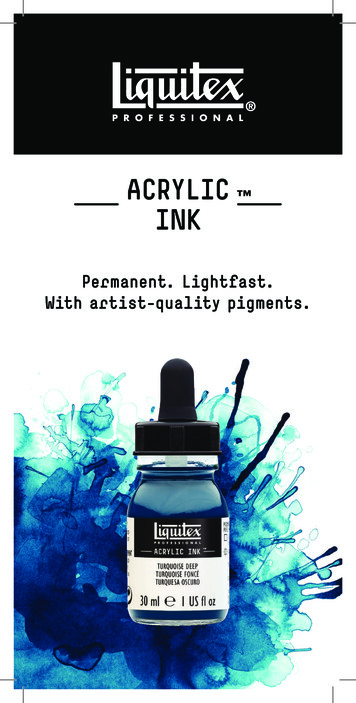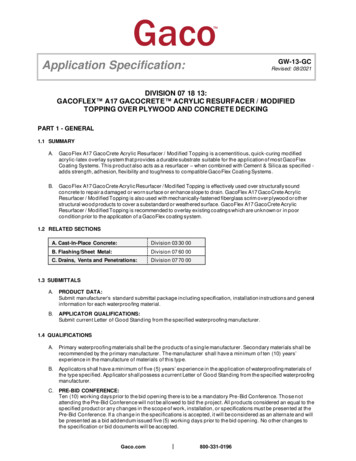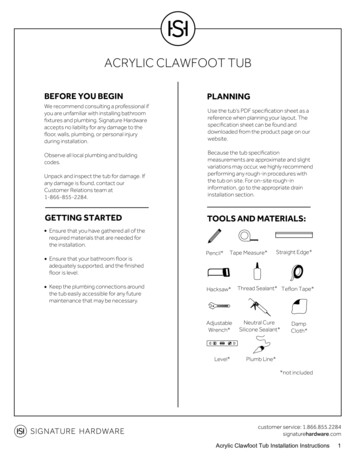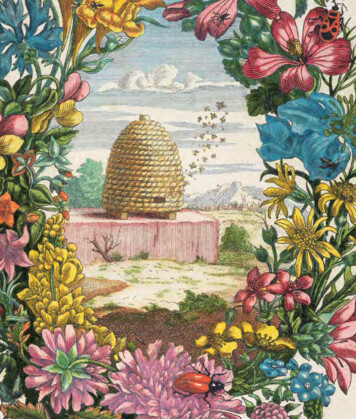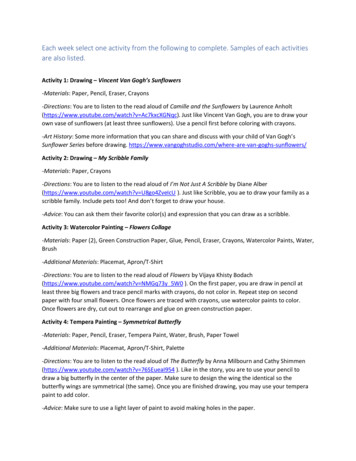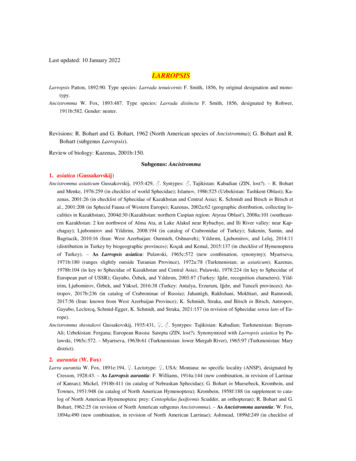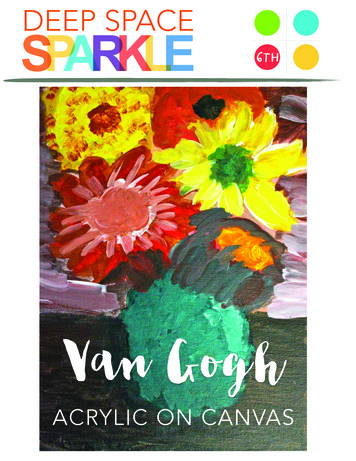
Transcription
DEEP SPACE6thVan GoghACRYLIC ON CANVAS
ABOUTthe artistABOUTVINCENTVAN GOGHVincent Van Gogh was born in Holland in 1853. He had two bothers and three sisters but wasclosest to his younger brother, Theo. Vincent loved to draw as a child and by the time he was 27years old, he devoted his whole life to painting.When Vincent first began painting, he painted images from his surroundings which were a bitgloomy. He used dark, sad colors. When he moved to France, he started to paint sunflowers.The colors he used became brighter and his iconic short brushstroke was developed. He paintedportraits, streets, cafes and countrysides.Vincent painted hundreds of pictures, sometimes finishing a single painting in a day. But then,Vincent became unwell and he moved into a hospital so others could take care of him. He died in1890.Facts: Van Gogh didn’t cut off his entire ear, only just the lobe. Van Gogh would paint for such a long time that he would forget to eat. He only sold one painting in his lifetime. 2015 DEEP SPACE SPARKLE/PATTY PALMER. All Rights Reserved www.deepspacesparkle.com 2
ABOUTthe paintingSUNFLOWERSSunflowers were special for Van Gogh. Yellow wasthe color of happiness for him and in theNetherlands, sunflowers were a symbol of loyaltyand devotion. When Van Gogh moved to Paris henoticed the work of the famous Impressionistpainters like Renoir and their use of bright,unmixed colors.Van Gogh liked the colors so much he began toexperiment with this new style of painting. Manyartists placed opposing colors next to each otherSunflowers, 1888, Oil on Canvas, PostImpressionism, National Gallery of Londonto bring out their intensity. Yellow would bepainted next to purple, reds next to greens, etc.Van Gogh tried this color idea and painted a vaseof sunflowers on a blue background. But he didn’tlike it as much as yellowflowers on yellowbackgrounds.Sunflowers, 1888, Oil on Canvas, PostImpressionism, Private Collection 2015 DEEP SPACE SPARKLE/PATTY PALMER. All Rights Reserved www.deepspacesparkle.com 3
SUNFLOWERS WITH ACRYLIC PAINTWHAT YOU’LL NEED:6” x 9” canvassheets or boardsPencilAcrylic paints are wonderful to paint with because theyare vibrant when applied and stay vibrant after they havedried.The drawbacks is that paint splatters are very hard toremove from clothing, although fingernail polish remover(acetate) works well.Acrylic paintsIt took me a long time to get on friendly terms withMedium and smallacrylics because they are more expensive and I didn’tbrushesknow how to prep them. If you don’t know what I mean,then I’m glad you are reading this.There are some “rules” that must be followed for you tohave a favorable experience with acrylic paints. 2015 DEEP SPACE SPARKLE/PATTY PALMER. All Rights Reserved www.deepspacesparkle.com 4
WHAT YOU NEED TO KNOW: ACRYLICSAcrylic paints are not like tempera paints or watercolorpaints.The first time I used acrylic paints in the art room, Iplaced them in my plastic muffin-style palettes just like Iwould have with my temper paints. This worked great. Icleaned the palettes by rinsing them off in the sinkallowing the acrylic paints to run down the drain.Bad idea.My sink was clogged for a month.Here’s the thing: acrylic paints dry to a plastic finish.They will clog your sink, ruin your brushes and adhere toyour palettes.You need to prep acrylics differently: Use waxed paper, magazine pages or paper platesfor palettes. Throw them away after use. You can’t really save unused acrylic paints, so onlyuse a very small amount. They go along way. The paints will dry out if you don’t use them, so mistpalettes with water or mix with some water from abrush. Canvas sheets are more economical than individual canvas boards and fit in portfolios better. Wash brushes THOROUGHLY in dish detergent & water. Do not use watercolor brushes. 2015 DEEP SPACE SPARKLE/PATTY PALMER. All Rights Reserved www.deepspacesparkle.com 5
DRAWING THE SUNFLOWERSI buy 12” x 16” canvas sheets for my acrylic projects and cut them in half. I do this just to savemoney. If you have a larger budget, use the whole sheet. For older students and because we areusing acrylic paints, I take more time with this project. I really want to give students the opportunityto create a piece of art that is truly representative of them.Because of this, I use pencils and don’t offer the step-by-step drawing guide.Children look at Van Gogh’s Sunflower painting and draw what they want using a pencil. In mydemonstration, I show them how to draw the important lines with pencil and to keep the shapes aslarge as they dare. Small, tiny shapes will be harder to paint. Most kids in sixth grade have noproblem drawing as large as they need it to be. 2015 DEEP SPACE SPARKLE/PATTY PALMER. All Rights Reserved www.deepspacesparkle.com 6
HOW TO DRAW VAN GOGH SUNFLOWERS 2015 DEEP SPACE SPARKLE/PATTY PALMER. All Rights Reserved www.deepspacesparkle.com 7
HAND DRAWN VASE SHAPES 2015 DEEP SPACE SPARKLE/PATTY PALMER. All Rights Reserved www.deepspacesparkle.com 8
PAINTING WITH ACRYLICSWhen it’s time to paint, I offer 3 colors of acrylicpaint to start with. I know that it will take mostkids about 30 minutes to paint the table top andbackground. I don’t want the acrylic to dry beforethey get to the next part. I squeeze a dime-sizedamount onto waxed paper or styrofoam tray.The limit of only three colors encourages the kidsto consider their colors. They can always changetheir minds and they can alway ask for more.I suggest two colors that are close to each otheron the color wheel then add white or blackdepending on whether they want a tint or shade.After the backgrounds are painted, the kids diveinto the petals. The only trouble-shooting Inoticed was that many kids were avoiding thepencil lines.They had a tendency to paint up tothe line, but not over it. Once they were madeaware, they painted over the pencil lines.My students aren’t used to painting with acrylics,so I had to remind them that the paint shouldn’tbe translucent. If they are seeing pencil lines andcanvas through the paint, the paint is too thin.They are adding too much water.Because of the detail expressed in this smallpainting, outlining doesn’t seem necessary. 2015 DEEP SPACE SPARKLE/PATTY PALMER. All Rights Reserved www.deepspacesparkle.com 9
VAN GOGH SUNFLOWERS DRAWING GUIDE 2015 DEEP SPACE SPARKLE/PATTY PALMER. All Rights Reserved www.deepspacesparkle.com 10
AGES 11-12 2015 DEEP SPACE SPARKLE/PATTY PALMER. All Rights Reserved www.deepspacesparkle.com 11
Artist StatementYour nameWHAT IS THE NAME OF YOUR ARTWORK?HOW DID YOU CREATE YOUR ARTWORK?(What tools, supplies and techniques did you use?)WHAT DOES THIS PIECE OF ART MEAN TO YOU?(You can use “I” statements and talk about your inspiration and what creatingthis piece of art means to you) 2015 DEEP SPACE SPARKLE/PATTY PALMER. All Rights Reserved www.deepspacesparkle.com 12
I can statements for van gogh sunflowers Today I will learn about OBSERVATION DRAWING, so that I CAN study Van Gogh’s Sunflowersand create my own version by rendering what I see in front of me and making it my own. Today I will learn about ACRYLICS, so that I CAN paint my own version of Sunflowers using acrylicpaint on canvas effectively and take proper care of the materials.Common Core STANDARDS for van goghsunflowersCCSS.ELA-Literacy.RI.6.7Integrate information presented in different media or formats (e.g., visually, quantitatively) as well asin words to develop a coherent understanding of a topic or issue.You can assess students’ understanding of the information presented on the life and work of VanGogh formally through verbal questions and answers. Students are presented the information viaPowerPoint, posters, etc. and may be given pages 2 and 3 of this packet to read and summarize themain ideas from the text before starting the artwork.CCSS.ELA-Literacy.SL.6.5Include multimedia components (e.g., graphics, images, music, sound) and visual displays inpresentations to clarify information.After students have completed their painting, they may use their work to present to the class howlearning about Van Gogh’s style influenced and inspired the decisions made in creating theircompositions. This further clarifies their understanding of the main ideas of Van Gogh’s style. 2015 DEEP SPACE SPARKLE/PATTY PALMER. All Rights Reserved www.deepspacesparkle.com 13
NATIONAL CORE ARTS STANDARDS - fifth gradeCREATINGXGenerate and conceptualize artistic ideas and work — combine ideas to generate anXOrganize and develop artistic ideas and work — experiment and develop skills in multipleXinnovative idea—demonstrate diverse methods to approaching art makingtechniques through practice—show craftsmanship through care—document objects ofpersonal significanceRefine and complete artistic work—create artists statements using art vocabulary todescribe personal choices in art-makingPresenting/producingAnalyze, interpret and select artistic work for presentation— define roles andXresponsibilities of a curator—explaining the skills/knowledge needed to preform curationDevelop and refine artistic work for presentation — develop a logical argument for safeand effective use of materials and techniques for preparing and presenting artworkConvey meaning through the presentation of artistic work —cite evidence of how anexhibition in a museum presents ideas and provides information about specific conceptsRespondingXXPerceive and analyze artistic work- compare interpretation of art to another’s interpretation—analyze cultural associations suggested by visual imageryInterpret intent and meaning in artistic work — interpret art by analyzing form, structure,context information, subject, visual elements, and use of media to identify mood and ideasXconveyedApply criteria to evaluate artistic work— recognize differences in criteria used to evaluateworks of art depending on stylesConnectingXSynthesize and relate knowledge and personal experiences to make art- apply formal andconceptual vocabularies of art and design to view surroundings in new ways through art-XmakingRelate artistic ideas and works with societal, cultural and historical context to deepenunderstanding 2015 DEEP SPACE SPARKLE/PATTY PALMER. All Rights Reserved www.deepspacesparkle.com 14
NATIONAL CORE ARTS STANDARDS - sixth gradeCREATINGXGenerate and conceptualize artistic ideas and work — Combine concepts collaboratively toXOrganize and develop artistic ideas and work — Demonstrate openness in trying new ideas,Xgenerate innovative ideas for creating art.materials, methods, and approaches in making works of art and design.Refine and complete artistic work—Reflect on whether personal artwork conveys the intendedmeaning and revise accordinglyPresenting/producingXAnalyze, interpret and select artistic work for presentation— Analyze similarities and differencesassociated with preserving and presenting two- dimensional, three- dimensional, and digitalartwork.Develop and refine artistic work for presentation — Individually or collaboratively, develop a visualplan for displaying works of art, analyzing exhibit space, the needs of the viewer, and the layout ofthe exhibit.Convey meaning through the presentation of artistic work —Assess, explain, and provide evidenceof how museums or other venues reflect history and values of a community.RespondingXXPerceive and analyze artistic work—Identify and interpret works of art or design that reveal howpeople live around the world and what they value.Interpret intent and meaning in artistic work — Interpret art by distinguishing between relevantand non-relevant contextual information and analyzing subject matter, characteristics of form andstructure, and use of media to identify ideas and mood conveyed.Apply criteria to evaluate artistic work—Develop and apply relevant criteria to evaluate a work ofartConnectingSynthesize and relate knowledge and personal experiences to make art- Generate a collection ofXideas reflecting current interests and concerns that could be investigated in art- making.Relate artistic ideas and works with societal, cultural and historical context to deepenunderstanding —Analyze how art reflects changing times, traditions, resources, and cultural uses. 2015 DEEP SPACE SPARKLE/PATTY PALMER. All Rights Reserved www.deepspacesparkle.com 15
This and many other bundles are included in The Members Club FULL access for a low monthly fee!The Members Club offers a monthly art curriculum, a growing bankof art lesson plans, live monthly teacher trainings, and a vibrantcommunity of teachers to support and celebrate YOURsuccess.Sign up for the WAITING LIST to learn when YOUcan join The Members Club!THE LESSONS INTHIS BUNDLE(AND MANYOTHERS!) AREINCLUDED IN THEMEMBERS CLUBART BANKJOIN THE WAITLIST 2015 DEEP SPACE SPARKLE/PATTY PALMER. All Rights Reserved www.deepspacesparkle.com 16
ASSESSMENT CHECKLISTMain Ideas from:ACRYLIC FLOWERSStudent Name:Can the student tell me about Vincent VanGogh?Did the student draw a sunflower still-lifeinspired by Van Gogh?Did the student handle the acrylic paintseffectively?DEEP SPACE SPARKLE & THE MEMBERS CLUB
Acrylic paints are not like tempera paints or watercolor paints. The first time I used acrylic paints in the art room, I placed them in my plastic muffin-style palettes just like I would have with my temper paints. This worked great. I cleaned the palettes by rinsing them off in the sink allowing the acrylic paints to run down the drain. Bad idea.
